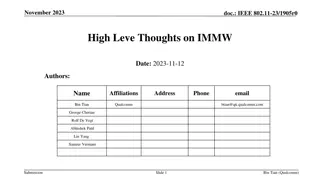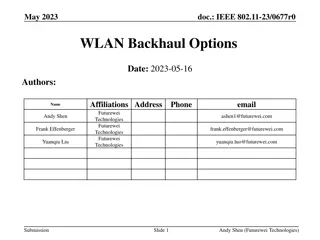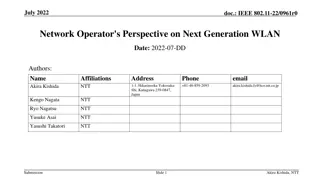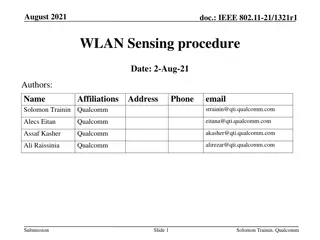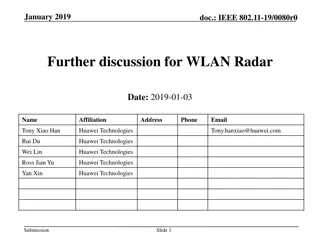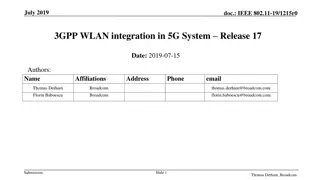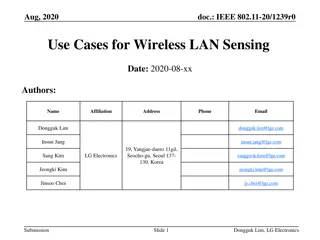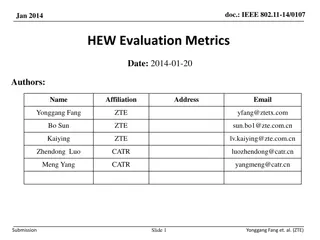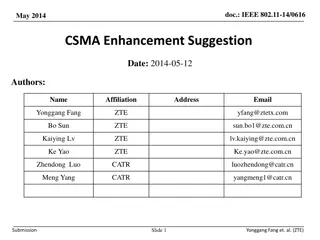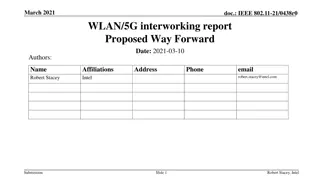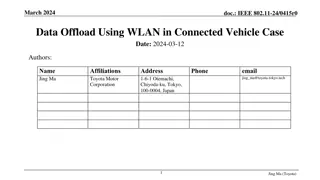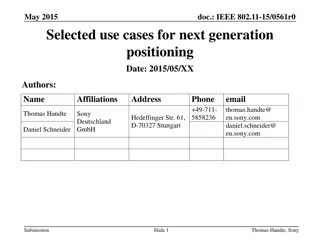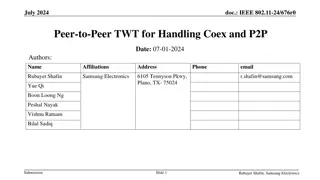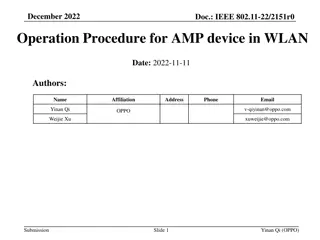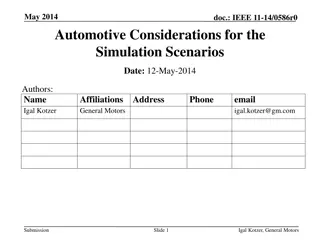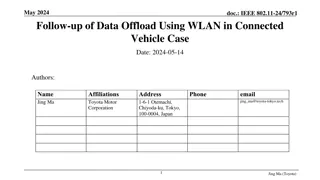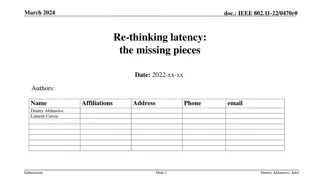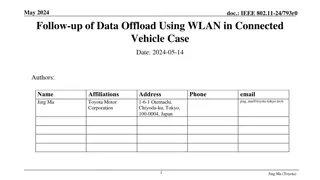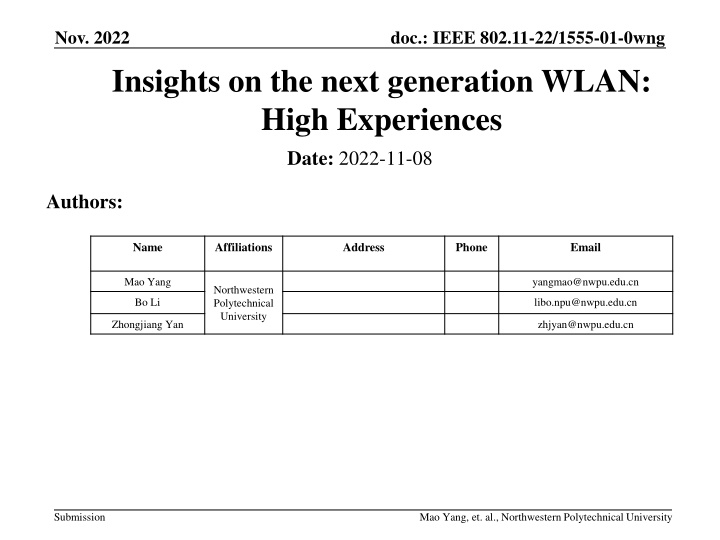
Insights on Enhancing WLAN User Experience Beyond IEEE 802.11be
Explore the challenges and solutions for improving user experience in WLAN, focusing on the persistent issue of poor Quality of Experience (QoE). This analysis delves into technical problems impacting WLAN performance, such as network architecture, channel access, transmission capabilities, QoS architecture, interference management, and the lack of AI integration. The article discusses the current state of WLAN in China, highlighting the preference for cellular networks over unstable and inconsistent free Wi-Fi services. Ultimately, the discussion centers on the necessity of addressing QoE to enhance the next generation of WLAN beyond the IEEE 802.11be standard.
Download Presentation

Please find below an Image/Link to download the presentation.
The content on the website is provided AS IS for your information and personal use only. It may not be sold, licensed, or shared on other websites without obtaining consent from the author. If you encounter any issues during the download, it is possible that the publisher has removed the file from their server.
You are allowed to download the files provided on this website for personal or commercial use, subject to the condition that they are used lawfully. All files are the property of their respective owners.
The content on the website is provided AS IS for your information and personal use only. It may not be sold, licensed, or shared on other websites without obtaining consent from the author.
E N D
Presentation Transcript
Nov. 2022 doc.: IEEE 802.11-22/1555-01-0wng Insights on the next generation WLAN: High Experiences Date: 2022-11-08 Authors: Name Affiliations Address Phone Email Mao Yang yangmao@nwpu.edu.cn Northwestern Polytechnical University Bo Li libo.npu@nwpu.edu.cn Zhongjiang Yan zhjyan@nwpu.edu.cn Submission Mao Yang, et. al., Northwestern Polytechnical University
Nov. 2022 doc.: IEEE 802.11-22/1555-01-0wng Introduction In previous WNG meetings, several contributions focusing on the next generation WLAN were proposed. D3.0 of IEEE 802.11be will probably been released in Nov. 2022. And the ultra high reliability (UHR) SG was established in Spet. 2022. It is the time to think about the objective of next generation WLAN (beyond 11be). In this contribution, we analyze the problem of the current WLAN, and propose that the most important problem is low user experience. Submission Mao Yang, et. al., Northwestern Polytechnical University
Nov. 2022 doc.: IEEE 802.11-22/1555-01-0wng Key Problem: poor QoE Increasing emerging, such as meta universe, VR, AR, digital twin, ultra-high, online real-time games, leading to higher requirements and more severe challenges QoE [1-4]. various applications and services are Poor quality of experience (QoE) is the most obstinate problem of the current WLAN. Submission Mao Yang, et. al., Northwestern Polytechnical University
Nov. 2022 doc.: IEEE 802.11-22/1555-01-0wng Key Problem: poor QoE Our feelings about the QoE In China, in many places, as long as the traffic usage fee of the cellular network is within the budget, people including us would rather choose 4G/5G than FREE WiFi. The problem is not the peak performance, but the stability of performance. WiFi performance changes dramatically over time. In my lecture, my students told me that almost the only reason to use WiFi was that it was cheap rather than experiences. In practice, the claimed very/extremely high throughput can hardly be experienced. Submission Mao Yang, et. al., Northwestern Polytechnical University
Nov. 2022 doc.: IEEE 802.11-22/1555-01-0wng Key Problem: poor QoE Poor QoE is caused by several technical problems. Network architecture: fully distributed networking architecture Channel access: chaotic random access Transmission: awkward high capability QoS guarantee: coarse-grained QoS architecture Interference management: ubiquitous and complicated interference Network intelligence: no place for AI Legacy dilemma: heavy burden of standard evolving Submission Mao Yang, et. al., Northwestern Polytechnical University
Nov. 2022 doc.: IEEE 802.11-22/1555-01-0wng Key Problem: poor QoE Poor QoE is caused by several technical problems. Network architecture: fully distributed networking architecture Management: ubiquitous and complicated interference Legacy dilemma: heavy burden of standard evolving Network intelligence: no place for AI Transmission: awkward high capability Channel access: chaotic random access QoS guarantee: coarse-grained QoS architecture Submission Mao Yang, et. al., Northwestern Polytechnical University
Nov. 2022 doc.: IEEE 802.11-22/1555-01-0wng Fully distributed networking architecture Definition: different from cellular network, WiFi adopts fully architecture. Distributed architecture has its advantages, but it usually leads to unordered network status, resulting in low QoE. distributed network Example Scenarios Within one BSS, the network is distributed although we have an AP The coordination within ESS is still very limited Even in deployed enterprise network, distributed feature also results in many problems such as starvation problem (flow-in-the-middle)[5] Submission Mao Yang, et. al., Northwestern Polytechnical University
Nov. 2022 doc.: IEEE 802.11-22/1555-01-0wng Fully distributed networking architecture Impact factors Lack of overall and top-level architecture design Fully distributed networking architecture for network management, control, and data transmission The current ISM band is limited and environment complicated Relationship with QoE Fully distributed networking architecture makes the network low efficiency, resulting in low QoE. Submission Mao Yang, et. al., Northwestern Polytechnical University
Nov. 2022 doc.: IEEE 802.11-22/1555-01-0wng Chaotic random access Definition: the STAs including APs randomly contend the channel, resulting in chaotic channel access between STAs. Example Scenarios Radical channel access: consistently use the maximum TX power, set the duration as TXOP limit that is larger than actual demand, and etc. For home and enterprise scenario, multiple BSSs or multiple STAs in one BSS are also enemies of each other in many places. For r-TWT in 11be D2.0, the rule Non-AP EHT STAs may behave as if overlapping quiet intervals do not exist exacerbates random collision. Once, a clean 6GHz band is ready for WiFi, but we make it random. Submission Mao Yang, et. al., Northwestern Polytechnical University
Nov. 2022 doc.: IEEE 802.11-22/1555-01-0wng Chaotic random access Impact factors Deep-rooted random channel access Rigid CCA and ED thresholds for diverse scenarios Lack of clean designed channel access structure The channel access rule for new band Relationship with QoE Chaotic random access significantly exacerbates the collision and ineffective access and transmission, which leads to low QoE. Submission Mao Yang, et. al., Northwestern Polytechnical University
Nov. 2022 doc.: IEEE 802.11-22/1555-01-0wng Awkward high capability Definition: MLO, 320MHz, 4096-QAM, 1024-aggregation, 16ss, and etc. sound attractive. However, the actual available performance is far from the capability. Chinese archaism: chicken ribs not bad enough to leave, but not good enough to stay. Example Scenarios High-dense scenario and the interference make it nearly impossible to achieve 320MHz. Maybe 20M and 40MHz is normal. 4096-QAM, even 1024-QAM, is difficult to use because of the unachievable SINR threshold. [Note]: 5G uses 256-QAM. 16ss is also challenging because of the inter- stream interference and complicated grouping. complicated 4096-QAM 320MHz 16ss user Submission Mao Yang, et. al., Northwestern Polytechnical University
Nov. 2022 doc.: IEEE 802.11-22/1555-01-0wng Awkward high capability Impact factors Complicated channel environment and interference Lack of mechanism to make these valuable technologies work in practice Increasingly low efficiency The higher the peak throughput, the lower the efficiency. Overhead 1: SIFS+BA Overhead 1: BO+RTS/CTS+N*SIFS+BA 1link+320MHz+4ss+MCS1 3+1024-aggregation 1link+320MHz+4ss+MCS1 3+1024-aggregation 1link+320MHz+4ss+MCS1 3+256-aggregation 60~100us 200~400us 710.52us 355.26us 88.81us Maximum PPDU length will restrict the aggregation size. 160MHz+2ss+MCS13+4096-aggregation Intended PPDU length: 11.368ms << maximum PPDU length 5.46ms Relationship with QoE A series of valuable technologies cannot be achieved in practice, thus high experiences are also unachievable. Submission Mao Yang, et. al., Northwestern Polytechnical University
Nov. 2022 doc.: IEEE 802.11-22/1555-01-0wng Coarse-grained QoS architecture Definition: the current QoS architecture is traffic class based, eight TIDs and four ACs can not keep pace with the increasingly diverse services. Example Scenarios Increasingly diverse services require quite diverse and challenging QoS VR, game, Metaverse, Digital twin, industry, remote medical, Unsolvable Low latency Although low latency is one feature of 11be, there are little effective solutions till D2.0 such as r-TWT. Several proposals discuss <1ms latency guarantee, which seems as an unsolvable objective for WiFi. Instable resource acquisition results in unstable performance Increasingly large bandwidth and other enablers are unfriendly to IoT. Seamless WiFi roaming is challenging Submission Mao Yang, et. al., Northwestern Polytechnical University
Nov. 2022 doc.: IEEE 802.11-22/1555-01-0wng Coarse-grained QoS architecture Impact factors QoS architecture with appropriate granularity Fine scalability Truly effective solution for low latency/jitter Stable resource acquisition Integrated wide band system and narrow band IoT Seamless WiFi roaming Relationship with QoE QoS is the premise of QoE, and poor QoS will inevitably lead to poor QoE. Submission Mao Yang, et. al., Northwestern Polytechnical University
Nov. 2022 doc.: IEEE 802.11-22/1555-01-0wng Ubiquitous and complicated interference Definition: network, the random interferences from OBSS, intra-BSS, and non-WiFi system are ubiquitous and complicated. quite different from cellular Example Scenarios High-dense deployment scenario will be typical. Devices made from different vendors adopt different implementations to select channels, bandwidth, access paras, and etc. Cross-system interferences from LAA, LTE-u, and etc. 11ax introduces SR, interferences which further increases Submission Mao Yang, et. al., Northwestern Polytechnical University
Nov. 2022 doc.: IEEE 802.11-22/1555-01-0wng Ubiquitous and complicated interference Impact factors Lack of inter-BSS coordination Complicated ISM band interferences Lack of explicit technical rules for the coexistence between WLAN and other systems Lack of new band for WLAN Relationship with QoE Interference leads to poor network performance and, consequently, poor network performance leads to poor QoE. Submission Mao Yang, et. al., Northwestern Polytechnical University
Nov. 2022 doc.: IEEE 802.11-22/1555-01-0wng No place for AI Definition: complicated. Make network more intelligent is a natural and promising target, but it seems there is no place for AI in standardization. user experience is subjective and Example Scenarios Several proposals discuss the importance of AI for WLAN. But, it seems that ML, DL, and RL are usually considered as internal tools for each single device Single device basedAI obtain limited gain Difficult to be standardized Lots of AI models, training methods, and algorithms. Simply standardize specific one is unscalable. AI WLAN Submission Mao Yang, et. al., Northwestern Polytechnical University
Nov. 2022 doc.: IEEE 802.11-22/1555-01-0wng No place for AI Impact factors What can AI do for WLAN? What can the standardization do for AI? Not simply model or algorithm How to give full play to the advantages of AI in network interconnection? What is the AI standardization architecture in IEEE 802.11? Relationship with QoE Network intelligence can help us to evaluate the complicated user experience, and help us to choose the optimal method to guarantee the QoE. Submission Mao Yang, et. al., Northwestern Polytechnical University
Nov. 2022 doc.: IEEE 802.11-22/1555-01-0wng Heavy burden of standard evolving Definition: WiFi 4->WiFi 5->WiFi 6->WiFi 7, it seems that every time evolving has no choice but to coexist with many versions of legacy STAs. Example Scenarios Any new generation has to keep good backward compatibility, which is a double-edged sword . The innovation is in chains. Compare: cellular network s unfettered evolving: new band, new design, new frame format, and etc. Once, a clean 6GHz band is ready for WiFi, but we simply summoned all the old technologies. The frame format is continuously patched. With the evolution of the standard, the patch is in tatters. EHT HE VHT HT non-HT we Submission Mao Yang, et. al., Northwestern Polytechnical University
Nov. 2022 doc.: IEEE 802.11-22/1555-01-0wng Heavy burden of standard evolving Impact factors Old versions and new version share the same band The devices especially the APs installed with new standard have to serve all old versions Frame format is full of patch, but still pay little attention to the scalable design or clean-sheet design Relationship with QoE Drop the heavy burden of legacy benefits to the technical innovation. It is easy for us to focus on and further guarantee the enhancement of the user experiences of the new generation standard. Submission Mao Yang, et. al., Northwestern Polytechnical University
Nov. 2022 doc.: IEEE 802.11-22/1555-01-0wng Conclusions Poor QoE is the most tricky problem affecting the evolving and user population of WLAN. Several technical reasons are proposed Feature Problem Threats Importance Network architecture fully distributed networking architecture Unordering Channel access chaotic random access Unordering Transmission Low efficiency awkward high capability QoS guarantee coarse-grained QoS architecture Weak Adaptability Interference management ubiquitous and complicated interference Unordering Network intelligence Weak Adaptability no place for AI Legacy dilemma heavy burden of standard evolving Hindering evolving Submission Mao Yang, et. al., Northwestern Polytechnical University
Nov. 2022 doc.: IEEE 802.11-22/1555-01-0wng Conclusions (cont.) The vision of wireless network is, in our opinion, to enable people to enjoy wireless and to enrich ubiquitous interconnection. WLAN has achieved and is achieving great success. Cisco Visual Networking Index Submission Mao Yang, et. al., Northwestern Polytechnical University
Nov. 2022 doc.: IEEE 802.11-22/1555-01-0wng Conclusions (cont.) It is the time for us to carefully think things from our god s (i.e., users ) perspective. Therefore, to achieve high experiences (HEX) is highly suggested as the key objective of the next generation WLAN. Keep curiosity and carry on. Submission Mao Yang, et. al., Northwestern Polytechnical University
Nov. 2022 doc.: IEEE 802.11-22/1555-01-0wng Reference [1] Dasari, Mallesham, et al. "Scalable Ground-Truth Annotation for Video QoE Modeling in Enterprise WiFi." 2018 IEEE/ACM 26th International Symposium on Quality of Service (IWQoS). IEEE, 2018. [2] Ligata, Amir, Erma Perenda, and Haris Gacanin. "Quality of experience inference for video services in home WiFi networks." IEEE Communications Magazine 56.3 (2018): 187-193. [3] Ligata, Amir, Erma Perenda, and Haris Gacanin. "Quality of experience inference for video services in home WiFi networks." IEEE Communications Magazine 56.3 (2018): 187-193. [4] Laulajainen, Jukka-Pekka, et al. "Study of YouTube demand patterns in mixed public and campus WiFi network." 2014 International Wireless Communications and Mobile Computing Conference (IWCMC). IEEE, 2014. [5] F: Shimizu H, Yin B, Yamamoto K, et al. Joint Channel Selection and Spatial Reuse for Starvation Mitigation in IEEE 802.11 ax WLANs[C]//2019 IEEE 90th Vehicular Technology Conference (VTC2019-Fall). IEEE, 2019: 1-6. Submission Mao Yang, et. al., Northwestern Polytechnical University

